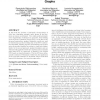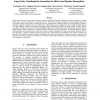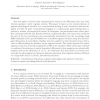873 search results - page 21 / 175 » Speaker segmentation and clustering |
MM
2009
ACM
14 years 1 months ago
2009
ACM
In this work the problem of automatic decomposition of video into elementary semantic units, known in the literature as scenes, is addressed. Two multi-modal automatic scene segme...
TASLP
2008
13 years 8 months ago
2008
Abstract--Motivated by potential applications in second-language pedagogy, we present a novel approach to using articulatory information to improve automatic detection of typical p...
LREC
2008
13 years 10 months ago
2008
Recent years have seen increased interest within the speaker recognition community in high-level features including, for example, lexical choice, idiomatic expressions or syntacti...
SPEECH
2010
13 years 6 months ago
2010
One key aspect of face-to-face communication concerns the differences that may exist between speakers’ native regional accents. This paper focuses on the characterization of re...
IDA
2003
Springer
14 years 1 months ago
2003
Springer
The segmentation of time-series is a constrained clustering problem: the data points should be grouped by their similarity, but with the constraint that all points in a cluster mus...



